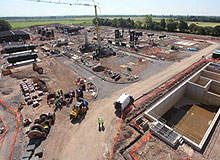
Holford Gas Storage Project, located in in Byley, Cheshire, UK is owned and operated by E.ON Gas Storage UK. The project became fully operational in February 2013.
The project included construction of an underground gas storage facility with a capacity to store 160 million cubic metres of gas. It features eight underground storage caverns and has A maximum injection and withdrawal rate of 22 million cubic metres of gas a day.
The Holford project enables gas transportation in and out of the UK’s National Transmission System. The capacity of the facility is equivalent to half of UK’s daily average gas demand.
The project reached an important milestone in May 2011 with first gas being injected into underground storage caverns. The first three caverns of the project became operational in December 2011. The three caverns together hold a capacity of 60 million cubic metres.
The Holford project is one of the many projects developed to address the decline in gas production levels in the UK. Gas production in the country has been declining at a rate of 7% a year.
Gas imports have been increasing as a result of this. By 2015, the UK is expected to import 80% of its gas.
Underground offshore storage facilities are being favoured as onshore projects are limited by the space needed to store large amounts of gas. Projects such as Holford help in increasing the security of supply. It also helps in addressing price volatility, as gas can be purchased at lower rates, stored and used during peak demand situations.
Construction and infrastructure of the Holford Gas Storage Project
Each cavern of the storage facility is 100m in diameter and 100m high. The construction was started in October 2008.
Eight wells were drilled to a depth of 700m into the salt layer in order to develop the caverns. Seven billion gallons of processed river water was then pumped into the caverns at high pressure.
The water dissolves the salt deposits to create a brine solution in a process called solution mining or leaching. The brine solution was later extracted.
Flow of water is controlled to create the desired shape and size of the cavern. Sonar surveys are used to monitor the size and shape of the cavern. Water flow is stopped and the leaching process is complete once the desired shape and size of the cavern is created.
Technology used at the Cheshire site
The storage facility features the ABB extended automation system. The system features multiple workstations and two 52in monitors to observe the site.
The system provides a single control access point for onsite personnel. It is connected to fire and gas alarms and compressor unit controls.
Contracts awarded to companies
Costain Group was awarded the engineering, procurement and construction contract for developing the infrastructure of the plant.
The scope of work included wellhead modifications and construction of infrastructure for pumping water and brine removal.
Costain subcontracted A.E. Yates Group for carrying out ground works, foundations and building works at the Cheshire site. Dutton Contractors was responsible for the installation of a vertical groundbed cathodic protection system at the facility.
Murphy Group was contracted to provide detailed design of the water and brine infrastructure required during the solution mining process. The value of the contract was £16.5m.
ABB was contracted to supply telecommunications equipment including surveillance, security and access control systems in February 2010.
The scope of work included installation of access control and intrusion detection equipment, fixed telephones and mobile radio system and a dedicated fibre optic network.
Pepperl+Fuchs supplied intrinsic safety isolated barriers for the facility. The equipment provided an interface between the devices installed at the facility and the safety instrumented system.
Noble Clean Fuels will utilise full storage capacity of the caverns under a five year agreement.



